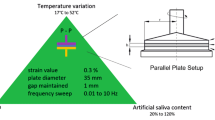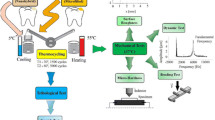Abstract
Soft denture liners and tissue conditioners are widely used for the denture patients to cushion masticatory force and condition abused tissues, respectively. This study assessed methods for the evaluation of the viscoelasticity and glass transition temperature (Tg) of the silicone permanent soft liner, acrylic permanent soft liner, and tissue conditioner. Three rheological parameters of storage modulus (E′), loss modulus (E′′), and loss tangent (\(\tan \delta\)), Tg, and hardness were determined using dynamic mechanical analysis (DMA), differential scanning calorimetry (DSC), and the Shore A0 hardness test. Five specimens were measured for each material. The time–temperature superposition principle was applied to produce master curves of E′, E′′, and \(\tan \delta\) for the tested materials at a reference temperature of 37 °C. The acrylic permanent soft liner and tissue conditioner exhibited viscoelastic behavior and sensitivity to frequency, especially at lower frequencies. The silicone permanent soft liner showed elastic behavior and was frequency-independent. Tg for the acrylic permanent soft liner was higher than that for the tissue conditioner, which in turn was higher than that for the silicone permanent soft liner for both DMA and DSC. In DMA, a higher frequency led to higher Tg values. A positive linear relationship was found between Shore A0 hardness and E′ values, but not E′′ and \(\tan \delta\) values. Shore hardness reflects elasticity, but not viscosity. The results of the present study can be used to improve methods for evaluating the viscoelasticity and Tg of soft denture liners and tissue conditioners.








Similar content being viewed by others
References
Yoshida M, Sato Y, Akagawa Y, Hiasa K. Correlation between quality of life and denture satisfaction in elderly complete denture wearers. Int J Prosthodont. 2001;14:77–80.
Marcello-Machado RM, Bielemann AM, Nascimento GG, Pinto LR, Del Bel Cury AA, Faot F. Masticatory function parameters in patients with varying degree of mandibular bone resorption. J Prosthodont Res. 2017;61:315–23.
Singhal S, Chand P, Singh BP, Singh SV, Rao J, Shankar R, Kumar S. The effect of osteoporosis on residual ridge resorption and masticatory performance in denture wearers. Gerodontology. 2012;29:1059–66.
Pound E. Conditioning of denture patients. J Am Dent Assoc. 1962;64:461–8.
Farrell DJ. Tissue conditioning and tissue conditioners. Dent Clin N Am. 1975;19:255–68.
Murata H, Hamada T, Djulaeha E, Nikawa H. Rheology of tissue conditioners. J Prosthet Dent. 1998;79:188–99.
Murata H, Hamada T, Sadamori S. Relationship between viscoelastic properties of soft denture liners and clinical efficacy. Jpn Dent Sci Rev. 2008;44:128–32.
Yamamoto S, Kimoto S, Saeki H, So K, Shinomiya M, Kobayashi K. In vitro study on changes in the stress behavior under simulated mucosa exposed to denture bases with different denture liners. Ann of Jpn Prosthodont Soc. 2009;1:277–83.
Kimoto S, Yamamoto S, Shinomiya M, Kawai Y. Randomized controlled trial to investigate how acrylic-based resilient liner affects on masticatory ability of complete denture wearers. J Oral Rehabil. 2010;37:553–9.
Murata H, Taguchi N, Hamada T, McCabe JF. Dynamic viscoelastic properties and the age changes of long-term soft denture liners. Biomaterials. 2000;21:1421–7.
Jones DW, Sutow EJ, Graham BS, Milne EL, Johnston DE. Influence of plasticizer on soft polymer gelation. J Dent Res. 1986;65:634–42.
Murata H, McCabe JF, Jepson NJ, Hamada T. The influence of immersion solutions on the viscoelasticity of temporary soft lining materials. Dent Mater. 1996;12:19–24.
Murata H, Haberham RC, Hmada T, Taguchi N. Setting and stress relaxation behavior of resilient denture liners. J Prosthet Dent. 1998;80:714–22.
Murata H, Taguchi N, Hamada T, Kawamura M, McCabe JF. Dynamic viscoelasticity of soft liners and masticatory function. J Dent Res. 2002;81:123–8.
Lacoste-Ferré MH, Demont P, Dandurand J, Dantras E, Blandin M, Lacabanne C. Thermo-mechanical analysis of dental silicone polymers. J Mater Sci. 2006;41:7611–6.
Ferry JD. Viscoelastic properties of polymers. 3rd ed. New York: Wiley; 1980. p. 11–4.
Nielsen LE, Landel RF. Mechanical properties of polymers and composites. 2nd ed. New York: Marcel Dekker Inc.; 1994. p. 135–54.
ASTM. E1640. Standard test method for assignment of the glass transition temperature by dynamic mechanical analysis. 1995.
McCabe JF, Wilson HJ. The use of differential scanning calorimetry for the evaluation of dental materials. J Oral Rehabil. 1980;7:235–43.
Waters M, Jagger R, Williams K, Jerolimov V. Dynamic mechanical thermal analysis of denture soft lining materials. Biomaterials. 1996;17:1627–30.
Nazhat SN, Parker S, Patel MP, Braden M. Isoprene-styrene copolymer elastomer and tetrahydrofurfuryl methacrylate mixtures for soft prosthetic applications. Biomaterials. 2001;22:2411–6.
Phoenix RD, Mansueto MA, Ackerman NA, Jones RE. Evaluation of mechanical and thermal properties of commonly used denture base resins. J Prosthodont. 2004;13:17–27.
Reis JMSN, Giampaolo ET, Pavarina AC, Machado AL, Erxleben J, Vergani CE. Exothermic behavior, degree of conversion, and viscoelastic properties of experimental and commercially available hard chairside reline resins. J Appl Polym Sci. 2011;122:1669–76.
Lombardo CE, Canevarolo SV, Reis JM, Machado AL, Pavarina AC, Giampaolo ET, Vergani CE. Effect of microwave irradiation and water storage on the viscoelastic properties of denture base and reline acrylic resins. J Mech Behav Biomed Mater. 2012;5:53–61.
Yoshida K, Kurogi T, Torisu T, Watanabe I, Murata H. Effects of 2,2,2-trifluoroethyl methacrylate on properties of autopolymerized hard direct denture reline resins. Dent Mater J. 2013;32:744–52.
Urban VM, Machado AL, Alves MO, Maciel AP, Vergani CE, Leite ER. Glass transition temperature of hard chairside reline materials after post-polymerisation treatments. Gerodontology. 2010;27:230–5.
Rodriguez LS, Paleari AG, Giro G, de Oliveira Junior NM, Pero AC, Compagnoni MA. Chemical characterization and flexural strength of a denture base acrylic resin with monomer 2-tert-butylaminoethyl methacrylate. J Prosthodont. 2013;22:292–7.
Takase K, Watanabe I, Kurogi T, Murata H. Evaluation of glass transition temperature and dynamic mechanical properties of autopolymerized hard direct denture reline resins. Dent Mater J. 2015;34:211–8.
International Organization for Standardization. ISO 10139-2. Dentistry—Soft lining materials for removable dentures—Part 2: materials for long-term use. 2016.
International Organization for Standardization. ISO 10139-1. Dentistry—Soft lining materials for removable dentures—Part 1: materials for short-term use. 2018.
Katakura N, Hosotani M, Iijima K, Honma H, Sakaguchi M. Tissue conditioners containing poly (butyl methacrylate) powder I Viscoelastic properties of homopolymer/plasticizer mixture. Dent Mater J. 1989;8:35–9.
Murata H, Taguchi N, Hamada T, Nikawa H. Dynamic viscoelastic properties of tissue conditioners in non-resonance forced vibration method. J Jpn Prosthodont Soc. 1996;40:590–7.
Japanese Industrial Standards. JIS K 7121. Testing methods for transition temperatures of plastics. 1978.
Huggett R, Brooks SC, Satguranathan R, Bell GA. Evaluation of analytical techniques for measurement of denture-base acrylic resin glass-transition temperature. Dent Mater. 1990;6:17–9.
Hong G, Maeda T, Li YA, Sadamori S, Hamada T, Murata H. Influence of PMMA polymer on the dynamic viscoelasticity and plasticizer leachability of tissue conditioner. Dent Mater J. 2010;29:374–80.
Hong G, Maeda T, Murata H, Sasaki K. The dynamic viscoelasticity and plasticizer leachability of tissue conditioners. Gerodontology. 2012;29:284–91.
Shohara K, Uotani K, Yamane H. Rheological and mechanical properties of particle filled elastomers. Nihon Reoroji Gakkaishi. 2003;31:329–35.
Acknowledgements
This work was supported by JSPS KAKENHI under Grant number 17H04393.
Author information
Authors and Affiliations
Corresponding author
Ethics declarations
Conflict of interest
The authors declare that they have no conflict of interest.
Additional information
Publisher's Note
Springer Nature remains neutral with regard to jurisdictional claims in published maps and institutional affiliations.
Rights and permissions
About this article
Cite this article
Kitagawa, Y., Yoshida, K., Takase, K. et al. Evaluation of viscoelastic properties, hardness, and glass transition temperature of soft denture liners and tissue conditioner. Odontology 108, 366–375 (2020). https://doi.org/10.1007/s10266-019-00477-9
Received:
Accepted:
Published:
Issue Date:
DOI: https://doi.org/10.1007/s10266-019-00477-9




